Mustard & Canola oil: – A king of all cooking oils
What is Mustard oil:-
Mustard oil commonly known as “Sarso ka tel” (सरसों का तेल) in india is a traditional edible oil extensively used in India for centuries. Kachi Ghani Mustard Oil (sarso oil) is extracted from mustard seeds (black, brown and white), and is reddish brown or amber in colour. It is used in Indian cooking from making pickles to dry vegetables to curries to fried foods. It is very-very common in the traditional Bengali cooking & cooking in bihar and Jharkhand region etc. it is also used for cooking in other parts of Assam, Orissa, U.P, Haryana, Punjab, Gujrat and other parts of India. In Indian kitchens, mustard oil is like the olive oil of India, the “king of all oils.”
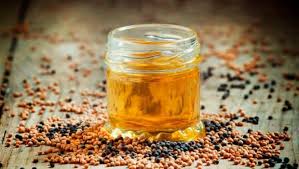

Pic source-food.ndtv
Why almost all cooking mustard oil are obtained from cold pressed method or kachi ghani method?
Mustard oil is simply extracted from the pure mustard seed and rapeseed and it is characterized by its strong smell and pungent taste. The mustard oil is mostly obtain by cold-pressing (40-45 degree C) of the seeds by the process of grinding in expellers or Ghanis where temperature is maintain at lower level during extraction. This helps to maintain the natural properties, antioxidants and essential oil in mustard oil. The essential oil content in kachi ghani mustard oil also act as a preservative.
There is also another method of extracting mustard oil by steam distillation method which is not very common due to health issue. By steam distillation methods mustard seed is passed through steam resulting the enzyme (Myrosinase or a Glucosinolate known as Sinigrin) which is found in the mustard seed when exposed to pressure or steam heat, they react and form allyl isothiocyanate or normal isothicyanate which is considered bad for our health. Steam distillation yields more oil but is not the best for health.
Therefore, traditionally as well as looking into health issue most of the mustard oil is extracted by cold pressing method or Kachhi Ghani. The black or brown mustard seed yields a lighter colored mustard oil and stronger tasting oil whereas the white or yellow mustard seed produces a yellowish colored & pungent mustard oil.
What is Kachhi Ghani process?
Kachchi ghani refers to cold press extraction process for taking out oil from mustard seeds. Traditionally, mustard oil were extracted in kohlus (wooden & now steel rollers) but in modern days it is done by machine or cold pressed oil extruder machine. In this process, seeds are crushed at low temperature so that natural properties, antioxidants and essential oils are retained in the oil.
Traditional Kachhi ghani extraction method:-
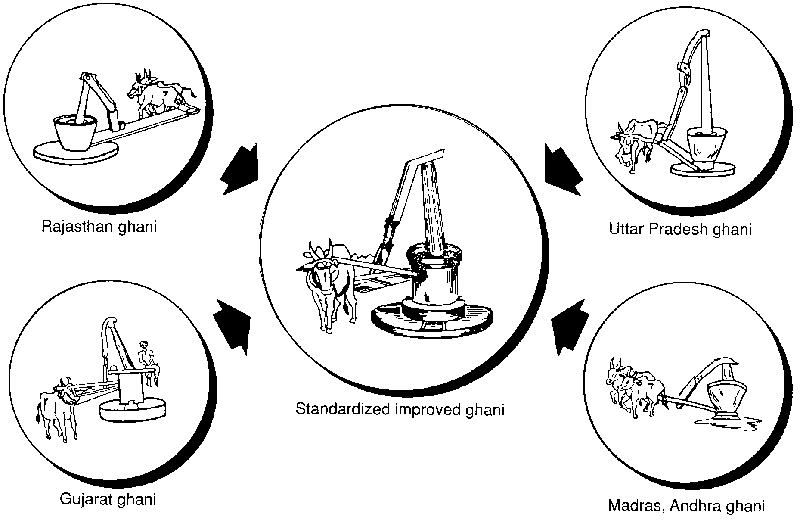
Pic source-fao.org
Cold pressed automatic machine


Pic source-youtube & Indiamart
Process of extraction of mustard oil by cold press method:-
The extraction of mustard oil involves 5 simple steps:-
Step-1:- The mustard seed should be sun dried completely before extraction process so that moisture from mustard seed should be evaporated and ready for extraction.
Step-2:- The dried mustard seed should be cleaned so that all dirt’s and foreign objects are removed from the mustard seed to ensure the extracted mustard oil is pure and of high quality.
Step-3:-Mustard seed is slightly heated before putting in extraction machine or grinding machine. This helps to increase the quantity of yield or higher yield of mustard oil. This process also increases the availability of protein in the by-product seed cake that is used for animal feeds.
Step-4:-After slightly heating the mustard seed is immediately feed into the extraction or grinding machine which is locally known as Ghani where the mustard seed are crushed and cold pressed at temperature of 40-45 degree C for upto an hour or more depending upon the quantity or volume of mustard seed. The crushing and pressing is continued further to extract all mustard oil from the seed resulting approx 30% of oil is obtain from mustard seed.
Step-5:- After oil is extracted, it is filtered to remove impurities and then bottled and lebeled as Kachhi Ghani sarson oil for sale.
How to check the grade & quality of mustard oil as per FSSAI Standards in India: –
Note:- PFA regulation is mandatory for all production of mustard oil, AGMARK’ for quality products & ISI Specification for Mustard Oil is IS:546:1975)
- Allyl isothiocyanate essential oil found in mustard oil is mainly responsible for pungent flavour. As per FSSAI Regulation, allyl isothiocyanate shall not be less than 0.20 %. The indian standard requirement is 0.20% to 0.60%. As per agmark, it should be in the range between 0.25% to 0.60% for grade-I oil and 0.10% to 0.60% for grade-II oil.
- Iodine value in mustard oil should be in range of 96 to 112 centigram of iodine absorption per gram of mustard oil as per FSSAI. The iodine value is a measure of unsaturation of fats & oils.
- Moisture in edible oil should not be more than 0.25% of net weight per volume as per FSSAI & Agmark standard.
- Specific gravity of mustard oil should be in range between 0.907 to 0.910
Grade or Type of mustard oil as per AGMARK:-
- Grade-1 mustard oil:- Grade I mustard oil is also known as raw grade and is obtained by a process of cold pressing. Grade I mustard oil is considered the standard of Kachchi ghani mustard oil. This kachhi ghani mustard oil is filtered after cold pressing through strainer to eliminate the solid particle and any impurities from the oil. No Chemical are added in this process that is the reason kachhi ghani mustard oil appears to be more dark and cloudy and their smell is more prominent of the mustard seed.
Mustard Oil” can only be labeled as “Kachi Ghani or filtered kachi ghani oil” if the content of allyl isothiocyanatein is not less than 0.2% by weight. Kachi ghani mustard oil is expected to be rich in presence of natural essential oil (allyl isothiocyanate) as it is extracted through cold pressing processes which retains the natural properties of mustard in end product and gives positive health impacts. As per AGMARK, it should be between the range of 0.25 to 0.60.
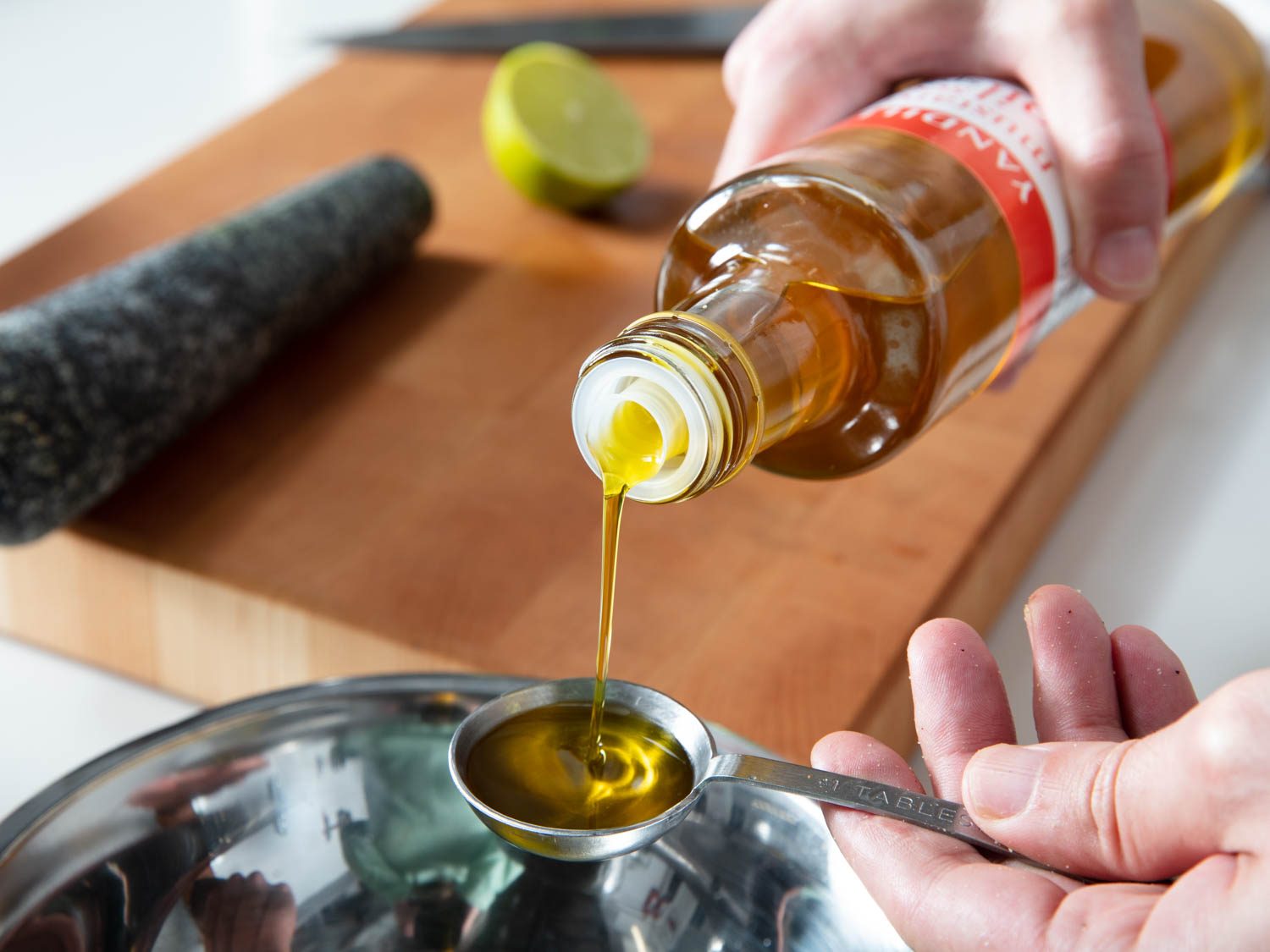
Pic source-serious eat
- Grade II mustard oil or Refined mustard oil- Refined mustard oil is obtained by a process of extraction of clean and sound Yellow, brown and black mustard seeds. The oil is refined by neutralisation with alkali &/or physical refining / or miscella refining and by using permitted food grade solvents followed by bleaching with absorbent earth & or activated carbon and deodorisation with steam. It is not generally used for edible purpose, but is widely used for other therapeutic uses.
Refined mustard oil which is considered as Grade-II mustard oil and mainly used for other therapeutic uses are mainly obtain from hot press process for extraction where oil undergo high temperature and are further treated with lot of chemicals to remove impurities, odour & color that is the reason refined oils is having very clear texture or color. Refined oil are sometimes double filtered to get more clear appearance and absolutely free from any smell.
Are Kachi ghani or filtered mustard oil is better than refined mustard oil?
Yes, definitely, filtered mustard oil is far better than the Refined mustard oil because filtered oil is extracted using cold pressing technique(kachi ghani technique) where low temperature(40-45 degree C) are applied and less processed & treated resulting nutrients are retained and the fatty acid bonds don’t become toxic. Also, there is No use of chemicals during processing. Hence filtered oil has higher value of nutrients retained in them whereas Refined oil are devoid of beta carotene, Vitamin E and many minerals.
Another benefit of using filtered mustard oil is that it is strong in aroma, higher in vitamins and minerals and it is used lesser in quantity as compare to Refined oil helping us to manage body weight and lipid level better.
Nutritional value in Kachi ghani mustard oil:-
Mustard oils are usually extracted from any of the mustard seed such as black, brown and white mustard seeds and provides heart-healthy benefits due to its balance of both poly- and monounsaturated fats. Mustard oil is also believed to provide benefits for the skin and hair. Mustard oil has high smoke point which is 250 degree C
Ayurveda highly recommends Kachi Ghani Oil in cooking as it is full of monounsaturated fatty acids. Our body needs oil in the ratio of 3:1 – three parts of polyunsaturated fatty acids and one part of saturated fatty acids. Monounsaturated fatty acids (MUFA) come under polyunsaturated. In addition, Cold Pressed Mustard Oil is full of MUFA which is very essential for our health. It’s good for the heart, lightens skin, helps in hair growth, prevents premature graying of hair, etc
It contains about 60%-69% monounsaturated fatty acids: 5- 33% erucic acid and 12% oleic acid. It has approximately 21% polyunsaturated fats: 6% alpha-linolenic acid, an omega-3 fatty acid, and 15% linoleic acid, an omega-6 fatty acid. It has 12% saturated fats.
Suggestion while selection best cooking oil:-
As we see in our daily life that most of the oil sold in the market are levelled as Refined or Double refined oil because processing of such refined or double refined oil is much easier and cost effective. Hence be intelligent and wise while selecting the right oil for your family. Don’t go on the advertisement shown in your television or news paper/magazine. Always choose Natural filtered oil or cold pressed oil as it contains No chemicals and higher value of Nutrients such as Vitamins & minerals, Natural flavour in them.
It is beneficial to consume a mix of edible oils to maintain a balance between the three fatty acids. All oils are good in one way or the other. It is advisable to use a combination of oils, either blended or by rotation so that you get the benefit of all.
Is there any agency which works on protection of consumer in india for FMCG Products:- (Ref:-consumer-voice.org)
Yes, Consumer voice is an independent Voluntary Organisation working in Interest of Consumer Education which has pioneered the protection of consumers in India and its activity is supported by Ministry of Consumer affairs, Govt. of India works to educate consumers and make them aware of their rights. Organization conducts independents research on various brands of FMCG Products in india and evaluate as per the FSSAI Standards or Agmark standards in India.
Details of mustard oil brand tested by Consumer Voice & recommendation of its quality for consumer use: –
Recently Consumer voice which is a voluntary organization based in delhi has tested 13 popular mustard oil brands in India in the month of May 2019 on various parameters of FSSAI, AGMARK Standard & NABL Laboratory testing on range of quality, safety and acceptability which includes essential oil content as per FSSAI Standards, Iodine value, acid value, moisture & insoluble properties, adulteration, appearance, color & flavour etc.
13 Nos of popular brands of kachchi ghani mustard oils namely dalda, Dhara, Emami, Engine, Fortune, Nature Fresh, Kanodia, Mahakosh, Fresh & Pure,P Mark, Patanjali, Reliance, Tez were taken up for comparative testing by consumers voice in month of May 2029.
Their results are as under-

Data Courtesy:-consumers voice

Pic source-Amazon & Indiamart.
How to check the quality of mustard oil whether it is genuine or fake or adulterated.
In market there are some mustard oil which are not pure mustard oil and is adulterated with cheap palm oil, crude rice bran oil, crude soya bean oil etc. it is also adulterated by mixing of toxic adulterants with Argemone oil (Argemone oil is extracted from argemone seeds. Consumption of argemone oil can lead to health disorder as it is toxic in nature) In humans, argemone oil contained in adulterated mustard oil causes oxidative stress and death of red blood cells
The purity of mustard oil can be checked or tested by the following way:-
- Freezing tests:-it is the best and easy way to determine the purity of mustard oil. For this take some mustard oil in bowl or cups and keep it in freeze for few hours. If oil found freezing then it is not pure mustard oil and it is possible that it is adulterated with either cheap crude oil, palm oil, argemone oil or harmful chemicals.
- Rubbing test:- Take some oil in your palm and rub it properly in your hand. If it leaves any trace of color and smells like a chemicals then it is adulterated.
- Nitric acid test:- Mix mustard oil with 5ml of nitric acid, if the mixture turns yellowish orange color then mustard oil is adulterated with toxic Argemone oil.
- Barometer test:- Pure mustard oil will show meter reading of 58 to 60.5 in barometer test. If barometer reading is more than 60.5 then mustard oil is adulterated.
In todays world with advances in anti-counterfeiting technology, there are many cheap brands sometimes using anti-counterfeiting solutions in their mustard oil to hide the duplicity or adulteration. In that case it is very hard to judge the purity of mustard oil from the above test. It is only judged with anti-duplication solution.
Culinary use of Mustard oil:-
“Nothing can beat mustard oil when it comes to traditional Indian cooking such as making indian gravy & curry. Mustard oil is mainly used in the kitchen for frying food due to its high smoking point and does not burn easily. It has smoking point of 250 degree C . Due to its typical flavour and its preservative quality it is extensively used in pickle & chutney preparation.
It is particularly common in the Bengali cooking as well as used for cooking in parts of Gujarat, Assam, Orissa, Bihar, Haryana, Punjab, and other parts of India.
Due to its pungent taste, mustard oil works as a taste enhancer in Bengali dishes like Machher Jhol, Jhal Muri and Muri Ghonto. In Bengal most of the fish & meat dishes are cooked in mustard oil whereas in state like bihar & Jharkhand it is also extensively used as a cooking oil. Mustard oil is the main base for tempering their dals, vegetable dishes. Due to its versatile use it is considered as eastern india’s olive oil. It is not only used as a cooking oil but also serve the purpose of salad oil.it is also used in traditional Kashmiri cooking
What is canola seed & Canola oil:-
Canola seed is a genetically modified rapeseed. Canola also belongs to the Brassica plant family as does mustard & rapeseed belong and their flowers both have bright yellow in color. Canola is a name applied to edible oilseed. Canola seeds contain about 45 percent oil. canola seeds are similar in size to black mustard seeds, and it look like brownish-black in color.
In the 1970s canola plant was created through traditional plant cross-breeding by Canadian scientists, Dr. Baldur Stefansson and Dr. Keith Downey, who selected rapeseed populations when looking for a crop that would produce a healthy, edible oil product. The new healthy oilseed plant was created through traditional cross breeding by removing two things found in the rapeseed plant: glucosinolates and erucic acid. Erucic acid was removed because it was believed to be inedible or toxic in high doses. Prior to canola oil, most of the oil Canadians used for food purposes was imported and people wanted a home-grown edible oil. Canola was selected from rapeseed. Canola is NOT rapeseed. It may look the same but it’s nutritional makeup is totally different. Canola came about only after years of hard work, research and countless field tests of new plant varieties.
By definition, if a seed is labeled “canola” it has to have less than 30 micromoles of glucosinolates and less than 2% of erucic acid.
The name “canola” was registered in 1979 by the Western Canadian Oilseed Crushers Association to describe “double-low” varieties. Double low indicates that the processed oil contains less than 2% erucic acid and the meal less than 3 mg/g of glucosinolates. Erucic acid is a fatty acid that has been related to heart disease.
The name comes from Can as in Canada and ola as in oil!. Also, both canola and rapeseed/mustard are used for getting oil from its seed but they have a couple of key genetic key difference-
canola is grown in Canada and Australia as well as in Europe and China. The canola crop is called “double low rapeseed,” referring to its low levels of erucic acid and glucosinolates
Pic of canola plant & Canola seed

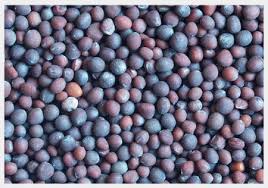
Pic source-featurepic.com
How canola oil is extracted from canola seed:-
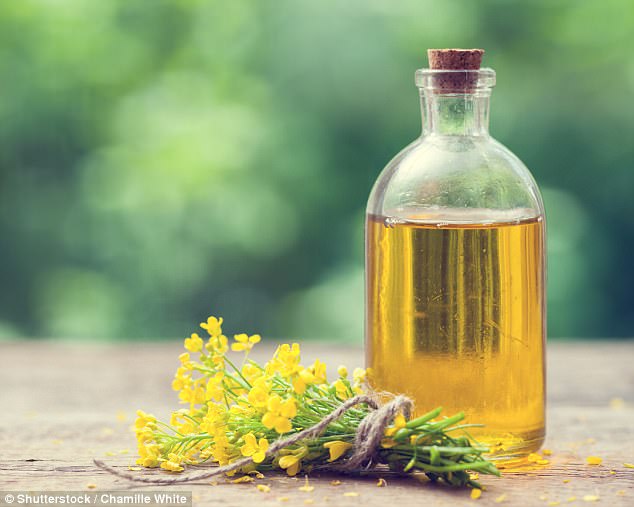
Pic source-shutterstock.
Canola oil is extracted by slightly heating the crushed canola seeds dissolved in the hexane solvent or by cold press method. Finally, it is refined using water precipitation and organic acid to remove gums and free fatty acids, filtering to remove color, and deodorizing using steam distillation. Canola oil is also called double zero meaning it has zero pungency and zero bitterness as compare to indian mustard oil that is the reason it is not very popular in India.
According to the Canola Council of Canada, this process involves the following steps-
- Cleaning of canola seed. Canola seeds are cleaned first to remove all impurities such as plant stalks,soil,dust and dirt.
- Heating the Seed: the canola Seeds are pre-heated to about 95℉ (35℃) and it is then “flaked” by special roller mills to rupture the cell wall of the canola seed. Then the flakes of the seed are cooked by a steam cooker at approx. temperature of 80-105 degree C.
- Pressing the seed:- The cooked canola seed flakes are then pressed in a series of screw presses or expellers machine to extract its oil from the flakes. Expellers are easily removes around 50–60% of the oil from the flakes, leaving the rest to be extracted by other means such as solvent extraction method. The remaining seed flakes oil which is approx. 18-20% are taken out by using a chemical called hexane.
- Processing the oil. The extracted oil is refined by varying methods, such as steam distillation, exposure to phosphoric acid, and filtration through acid-activated clays.
Although unrefined, cold-pressed canola oils do exist but is very expensive and hard to find. most canola on the market is highly refined.
Nutritional value in canola oil:-
Canola is generally considered a Healthy oil due to its low level of saturated fat content and significant amount of phytosterols (about 0.9% by weight) that reduce the absorption of cholesterol into the body.
- Saturated fat: 7%
- Monounsaturated fat: 64%
- Polyunsaturated fat: 28%
The polyunsaturated fats in canola oil include 21% linoleic acid —which is more commonly known as omega-6 fatty acid and 11% alpha-linolenic acid (ALA), a type of omega-3 fatty acid derived from plant sources. canola oil may contain up to 4.2% of trans fats, but the levels are highly variable and usually much lower
Canola oil has the least saturated fat (7%) which is less than a third that of rice bran oil (25%) and nearly half that of sunflower (12%), olive (15%), soybean (15%) and groundnut (19%) oils – and the most plant-based omega-3 fat of all common cooking oils. It helps in lowering cholesterol levels, and could be beneficial for heart patients.
List of most popular Canola Oil Brands in India (2020)
Canola oil India are generally imported from Canada. Canada exports more than 90% of its canola seed and canola oil in international market. The biggest buyer of canola oil from Canada is USA, Mexico, Japan, china. India has very minimal consumption of canola oil due to its zero pungency & zero bitterness. However there are some popular imported brands of canola oil are available in indian market .
Price range of canola oil in Indian market:- Its price range are in between Rs 170-200 per ltr depending upon the brand names.
Popular canola oil Brand | Pic. of canola oil brand |
Hudson Canola Oil- This canola oil is from Hudson is a vegetarian product. It is a perfect oil for all types of cooking like deep frying, microwaving and even for the everyday cooking. It has a very high smoking point that makes it one of the best oils for deep frying like in Indian Kitchen. | |
Borges Canola OilBorges canola oil is rich in Omega-3 fatty acids and low saturated fats like MUFA (monounsaturated fatty acids) and PUFA (polyunsaturated fatty acids). This oil is good for deep frying and other types of cooking that we do in Indian Kitchen. Canola oil is also good for brain functioning and lessening the bad cholesterol. | |
Pure Harvest Canola Oil-It is packaged and manufactured in Canada. The product is 100% vegetarian Omega 3 fatty acids along with the heart healthy cholesterol. It is rich in Alpha linolenic acid and linoleic acid. These fatty acids protects your heart against the diseases like strokes, artery hardening, etc. | |
Jivo Canola Refined EdibleJivo is perfect oil for all types of frying and cooking. It makes food super light and absorbs less in the food. Very high smoking point of 242 degrees makes it ideal for deep frying. It does not change the taste or aroma of food. | |
Miller Canola OilMiller presents the finest quality of Canola Oil from the farms of Canada. The balance of Omega 3 and 6 fatty acids is in the 2:1 ratio. It is perfect for all cusines- including Indian & Western. Miller oil can be used for frying, roasting, grilling, satuteing and also as Salad dressing. |





